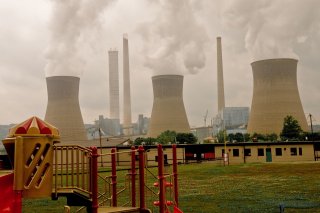Human Health & Environmental Impacts of the Electric Power Sector
Human Health Impacts

Despite years of progress in reducing pollution from the electric power sector, fossil fuel-fired power plants remain a leading source of air, water, and land pollution that affects communities nationwide.
There are more than 3,400 fossil fuel-fired power plants in the U.S. Collectively, these power plants are the largest stationary source category of nitrogen oxides (NOX) and sulfur dioxide (SO2) emissions and a significant source of mercury (Hg) and fine particle emissions. Fossil fuel-fired power plants are also a significant source of emissions of carbon dioxide (CO2), an important greenhouse gas.
NOX is a collective term for a group of highly reactive gases that are emitted not just from power plants but also motor vehicles and other sources. NOX emissions contribute to the formation of ground-level ozone and fine particle pollution, which cause a variety of adverse health effects.
SO2 is a highly reactive gas that is generated primarily from coal-fired power plants. In addition to contributing to the formation of acid rain and fine particle (PM2.5) pollution, SO2 emissions are linked with a number of adverse effects to human health and ecosystems.
Elevated concentrations of ground-level ozone and fine particles, which research shows aggravate heart and lung disease, can lead to heart attacks, asthma attacks, stroke, increased susceptibility to respiratory infection, and other serious health effects. Every year, pollution from power plants causes fine particle- and ground level ozone-related premature deaths, new asthma cases and asthma exacerbations, heart attacks, and lost school and work days.
Power plants are the largest source of airborne emissions of mercury. Mercury is a potent neurotoxin which affects the nervous system and brain functions, particularly in infants and children, and is known to cause other significant health effects. Among the 188 hazardous air pollutants (HAPs), or air toxics, that are emitted by power plants, mercury has been a principal HAP of concern.
Electric power generation is the second largest emitter of carbon dioxide pollution, contributing to climate change, which is threatening public health and affecting ecosystems at multiple levels, from the biological communities that make up ecosystems to the services they provide to communities, economies, and people. Learn more about the impacts of climate change on human health.
Some people are disproportionately affected by pollution from power plants. EPA is advancing the goals of environmental justice for all Americans, including those historically marginalized, overburdened, underserved, and living with the legacy of structural racism.
Environmental Impacts
These pollutants also harm our natural environment. For example, acid deposition, more commonly known as acid rain, occurs when emissions of SO2 and NOX react in the atmosphere with water, oxygen, and oxidants to form various acidic compounds. These acidic compounds then fall to earth in either a wet form (rain, snow, and fog) or a dry form (gases, aerosols, and particles). At certain levels, the acidic compounds, including small particles such as sulfates and nitrates, can cause many negative environmental effects including degraded air quality, impaired visibility, and acidified lakes and streams, negatively impacting aquatic life and harming sensitive plants and animals.
In addition, NOX emissions from electric power generation are a large source of atmospheric nitrogen deposition, which contributes to nutrient enrichment of aquatic and terrestrial ecosystems. This increased nitrogen pollution reduces plant biodiversity and alters the growth and survival of plants, lichens, and other organisms, potentially leading to changes in the biological community. Nutrient pollution also causes eutrophication of freshwater waterbodies and coastal estuaries, which alters aquatic communities and biodiversity and may lead to harmful algal blooms.
Ground-level ozone also can make plants more susceptible to disease, insects, fungus, harsh weather, and other stressors. These impacts can also lead to changes in the biological community, both in the diversity of species and in the health, vigor, and growth of individual species.
Electric power generation is a significant source of toxic metals and other pollutants discharged into water bodies, as well as land pollution through the disposal of millions of tons annually of coal ash, which can contain contaminants like mercury, cadmium, and arsenic. Cooling water intake structures cause adverse environmental impacts by pulling large numbers of fish and shellfish or their eggs into a power plant's or factory's cooling system.
Carbon dioxide emissions from power plants contribute to climate change, which affects ecosystems in multiple ways. Climate controls how plants grow, how animals behave, which organisms thrive, and how they all interact with the physical environment. As habitats experience different temperatures, precipitation patterns, and other changes, the organisms that make up ecosystems feel the effects. All U.S. regions are experiencing the impacts of climate change but impacts vary by area and ecosystem. Learn more about the impacts of climate change on the environment.
